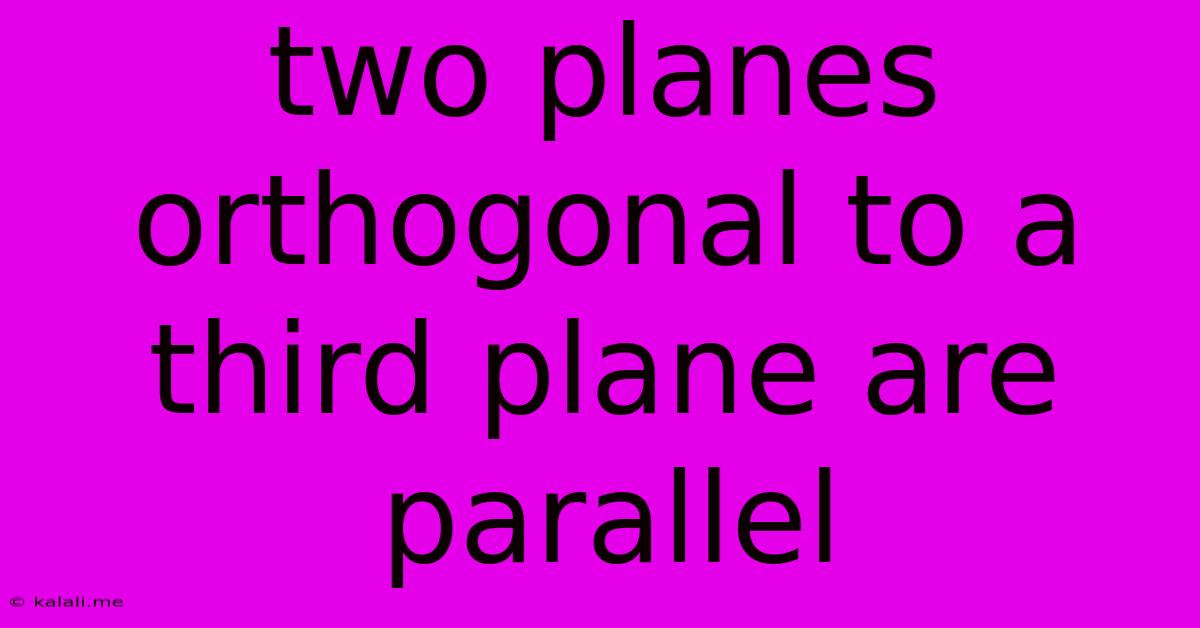Two Planes Orthogonal To A Third Plane Are Parallel
Kalali
Jun 09, 2025 · 3 min read

Table of Contents
Two Planes Orthogonal to a Third Plane are Parallel: A Geometric Proof
This article explores the fundamental geometric theorem stating that if two planes are both orthogonal (perpendicular) to a third plane, then these two planes must be parallel to each other. This seemingly simple concept forms a cornerstone of spatial reasoning and has practical applications in various fields, including computer graphics, engineering, and crystallography. We will delve into a rigorous proof of this theorem and illustrate it with intuitive examples.
Understanding this theorem requires a grasp of basic plane geometry concepts like orthogonality (perpendicularity) and parallelism. We will assume a basic understanding of these concepts to proceed with the proof.
Understanding Orthogonality and Parallelism in Three Dimensions
Before diving into the proof, let's solidify our understanding of the key terms:
-
Orthogonal Planes: Two planes are orthogonal if their normal vectors are orthogonal (i.e., their dot product is zero). Visually, this means the planes intersect at a right angle.
-
Parallel Planes: Two planes are parallel if their normal vectors are parallel (i.e., one is a scalar multiple of the other). This signifies that the planes never intersect.
The Proof: Demonstrating Parallelism
Let's consider three planes: Plane A, Plane B, and Plane C. We are given that Plane A is orthogonal to Plane C, and Plane B is also orthogonal to Plane C. Our goal is to prove that Plane A and Plane B are parallel.
-
Normal Vectors: Every plane has a normal vector, which is a vector perpendicular to the plane. Let's denote the normal vectors of Plane A, Plane B, and Plane C as n<sub>A</sub>, n<sub>B</sub>, and n<sub>C</sub> respectively.
-
Orthogonality Condition: Since Plane A and Plane B are orthogonal to Plane C, their normal vectors are orthogonal to n<sub>C</sub>. Mathematically, this means:
n<sub>A</sub> ⋅ n<sub>C</sub> = 0 and n<sub>B</sub> ⋅ n<sub>C</sub> = 0
where "⋅" represents the dot product.
-
Implications of Orthogonality: The above equations imply that both n<sub>A</sub> and n<sub>B</sub> lie in a plane perpendicular to n<sub>C</sub>. This plane is essentially defined by all vectors orthogonal to n<sub>C</sub>.
-
Parallelism Conclusion: Because both n<sub>A</sub> and n<sub>B</sub> reside within the same plane (perpendicular to n<sub>C</sub>), they must be parallel to each other, or one is a scalar multiple of the other. Therefore, Plane A and Plane B are parallel.
Visualizing the Theorem
Imagine a building with walls representing planes. If two walls (Plane A and Plane B) are both perpendicular to the floor (Plane C), it's intuitively clear that those walls are parallel to each other. This simple analogy effectively captures the essence of the theorem.
Applications and Extensions
This seemingly simple geometrical theorem has broad implications in various fields. It's crucial in:
- Computer Graphics: Defining and manipulating 3D objects and scenes.
- Engineering: Designing structures and ensuring stability.
- Crystallography: Understanding crystal structures and their symmetries.
This theorem provides a solid foundation for more complex geometric proofs and spatial reasoning. By understanding this fundamental principle, we can better comprehend and solve problems involving three-dimensional geometry. Further exploration could involve extending this concept to more complex geometrical structures and investigating related theorems in higher dimensions.
Latest Posts
Latest Posts
-
How Much Oz In A Bottle Of Water
Jul 01, 2025
-
How Long Does It Take To Drive 10 Miles
Jul 01, 2025
-
How Many 9s Are In A Deck Of Cards
Jul 01, 2025
-
How Many Pounds Are In 2 5 Kg
Jul 01, 2025
-
Which Is Greater 2 3 Or 2 4
Jul 01, 2025
Related Post
Thank you for visiting our website which covers about Two Planes Orthogonal To A Third Plane Are Parallel . We hope the information provided has been useful to you. Feel free to contact us if you have any questions or need further assistance. See you next time and don't miss to bookmark.